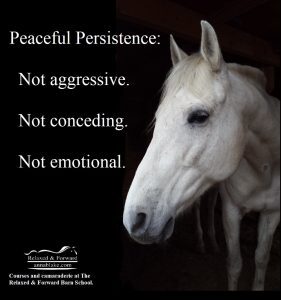Calming Signals: Haunted by a Black Cat in a Pink Dress.

I was taking the trash out to the dumpster in the alley. As I reached the back gate, I saw something moving frantically. I couldn’t make it out. It was pink and black and flapping about in a dusty pothole. It was the kind of thing you aren’t sure you should walk toward. Then it stopped suddenly and when the dust settled, I could see two pointy black ears. Black legs splayed wide. I stood still. It was a short-haired cat, but what was that pink? Then the cat started flailing again. Think salmon out of water, she flipped herself in all directions. Did she have a bird? A rat? Rabies? She landed again, this time facing the other direction, legs stretched wide.
Finally, I could make it out. The cat was wearing an old-fashioned doll’s dress. It had a fitted bodice and a full skirt. Buttons in back, that were near to popping, and little short puff sleeves. The kind of dress my mother made me wear when I was a kid, and even the memory made me feel claustrophobic. The cat sprang into the air again, twisting and flipping about, and I knew exactly what she was trying to do.
I guessed the cat had escaped a tea party. She might have run for miles trying to get out of that dress. I took a step closer to see if I might free her, but she bolted into some bushes and was gone. She had clearly reached her limit with humans.
It was decades before social media existed. Now pets have pages dedicated to their exploits. Each adventure has a new wardrobe. We are so used to seeing Wegman’s Weimaraners that a naked Weimaraner is a little embarrassing. Chickens wear sporty knitted hats. A cat in a pink dress wouldn’t stand out at all. I confess, I am as uncomfortable seeing pets in clothes now as I was then. But what was it about that pink dress?
Better to ponder the big questions about animals. Where would civilization be without beasts of burden? Without dogs protecting the herd and camp? Without fiber for clothing. Food to sustain us. These days, we need animals less for survival, and use them for recreational activities and emotional support. For their unique non-judgmental company.
There is no denying the beauty of a cat sleeping in the sun. The daily blessing of being met at the door with the dog’s tail wagging. Or the absolute miracle of a horse of our own. We secretly, or not so secretly, think animals are easier to get along with than our immediate family. We love them, and just being the recipient of our big, assertive emotion is a full-time job for many animals.
I’ve spent decades training horses professionally, living with dogs and goats and llamas, also trained to do various things. (I’ve never trained a cat to do anything.) In my experience of learning animal behaviors and training theories, I’ve been guilty of oversimplifying. I labeled methods as cruel or kind, but the thing that both training practices have in common is that we are molding animals to suit us. The methods vary, but it’s us giving animals a job that serves us. Always about us.
Granted, we are the ones who pay the bills. And that might matter if animals were aware of it. They’re not.
Humans can be needy and if you pay attention to their calming signals, it makes our animal friends uncomfortable. Do we put too much of an emotional burden on our companion animals? We even say the rescue animal saved us in a clever, self-deprecating way, but what if it’s true? I worry we are a damaged species who use other animals as bandaids. I know I have.
I believe the emotional state of an animal during training is more important for success than any specific techniques used. Training is a negotiation between the animal’s instinct and our desire. Do we alter them to fit into our world or change ourselves to fit their reality? Do I value my animal by what I can train them to do for me? Or take pride in prioritizing the mental welfare of my animal above the tasks I am training. I can testify that the second method is slower.
And that brings me back to that silly pink dress. When you think about it, isn’t ignoring or negating another’s feelings when cruelty begins?
Humans want what we want. We grow up believing that we are the dominant species, and we rarely question it. Until we get a reactive rescue dog or a horse who had a rough start. Soon it’s obvious that the same handling that created these problems won’t be what heals them. We have to do better.
 Best training practices always say there is no place for emotion in training, but it’s not simple as seeing animals as more than cute. Wanting the animal’s acquiescence can be a sweet energy or a dark fervor. Aspiration can be a positive encouragement or a fear-based attack. But even now, it’s all about us. Our feelings about their behavior rather than their feelings about ours. Do we even consider respecting their emotions, or does our love make us blind?
Best training practices always say there is no place for emotion in training, but it’s not simple as seeing animals as more than cute. Wanting the animal’s acquiescence can be a sweet energy or a dark fervor. Aspiration can be a positive encouragement or a fear-based attack. But even now, it’s all about us. Our feelings about their behavior rather than their feelings about ours. Do we even consider respecting their emotions, or does our love make us blind?
Some of us are born thinking animals are magic. We begin innocently reaching to hold them. Dreaming of ponies. Trying to carry boneless cats, and chasing after dogs. Playing dress up and serving tea.
There were years I fought my emotions like a lion tamer with a whip and a chair. I could see how overt love intimidated horses. Call it being a horse-crazy girl, but with the best intentions, my love deafened the conversation. It was the last thing I wanted.
Now I am a gray mare. Maybe emotional maturity just takes this long. Maybe understanding their calming signals has changed me beyond recognition. But it’s finally gotten easier to let the animal’s emotions come first. To listen without interruption. To keep my hands in my pockets.
Maybe I have become cold-hearted, but my own emotions have become a distraction, even a liability. They only cloud my perceptions. Horses, or any other animal frankly, have become more interesting than my feelings.
…
An audio version of this essay is available to those who subscribe on Substack.
Relaxed and Forward Training by Anna Blake is no longer on Facebook because of repeated hacking. If you or your horse appreciate my writing, please share, subscribe to this blog, or join me at The Barn School.
 The Barn School, is a social and educational site, along with member sharing and our infamous Happy Hour. Anna teaches courses like Calming Signals and Affirmative Training. Everyone’s welcome.
The Barn School, is a social and educational site, along with member sharing and our infamous Happy Hour. Anna teaches courses like Calming Signals and Affirmative Training. Everyone’s welcome.
Want more? Become a sustaining member, a “Barnie.” Subscribe to our online group with affirmative demonstration videos, audio blogs, daily quotes, free participation in group lessons, and live chats with Anna. Become part of the most supportive group of like-minded horsepeople anywhere.
Visit annablake.com for archived blogs, signed books, to schedule a live consultation, subscribe to this blog, or ask a question about the art and science of working with horses.
Ride for a new brand, find our Relaxed & Forward and Undomesticated Women swag at Zazzle.
Affirmative training is the fine art of saying yes.
 Available Now! My new travel memoir is Undomesticated Women, Anecdotal Evidence from the Road. Ride along on a clinic tour through 30 states, 2 oceans, and 14k miles with me and my dog, Mister. It is an unapologetic celebration of sunsets, horses, RV parks, roadkill, diverse landscapes, and undomesticated women. Available now at Amazon, Barnes and Noble, and signed copies from me.
Available Now! My new travel memoir is Undomesticated Women, Anecdotal Evidence from the Road. Ride along on a clinic tour through 30 states, 2 oceans, and 14k miles with me and my dog, Mister. It is an unapologetic celebration of sunsets, horses, RV parks, roadkill, diverse landscapes, and undomesticated women. Available now at Amazon, Barnes and Noble, and signed copies from me.
…
The post Calming Signals: Haunted by a Black Cat in a Pink Dress. appeared first on Anna Blake.



